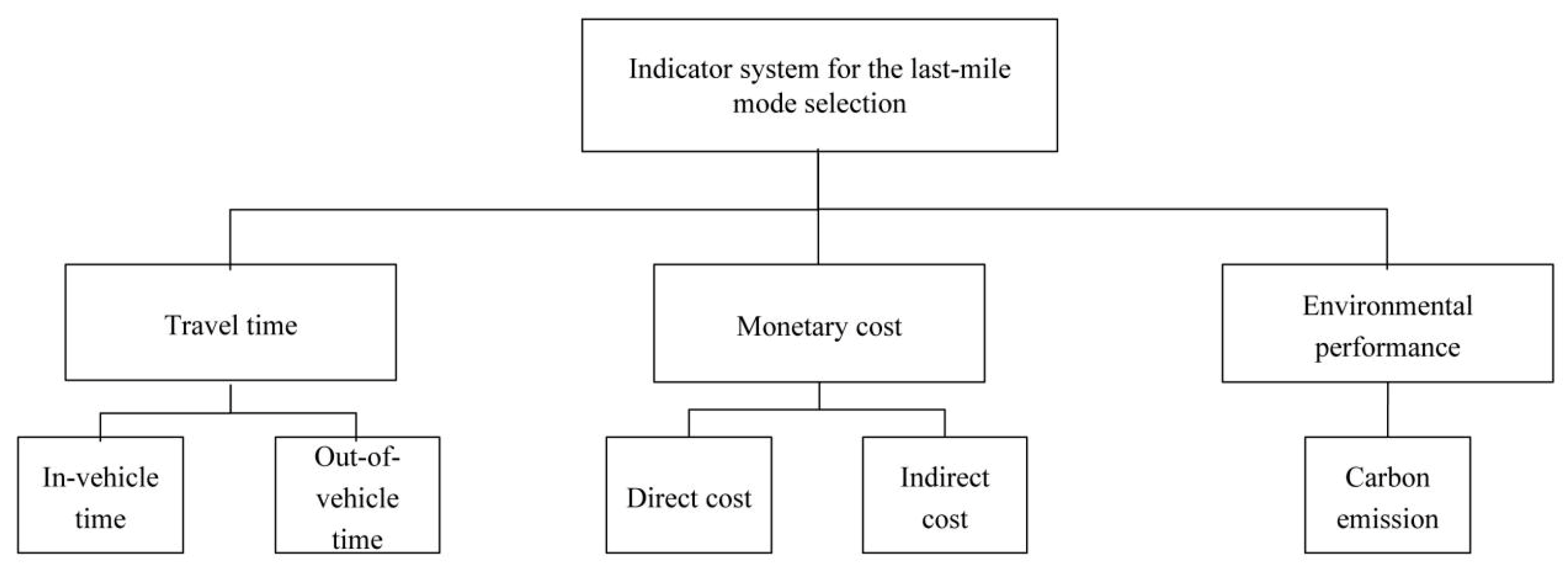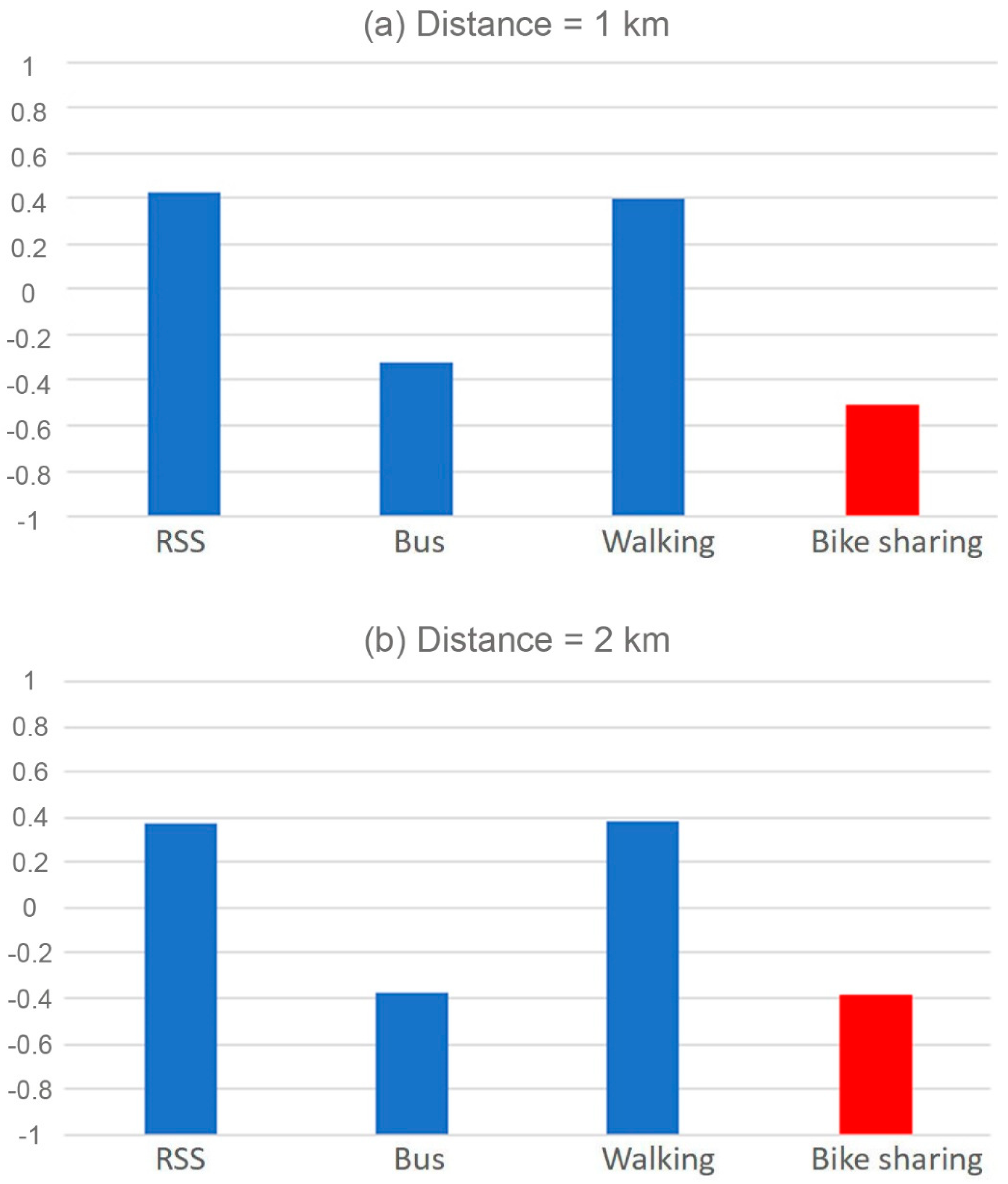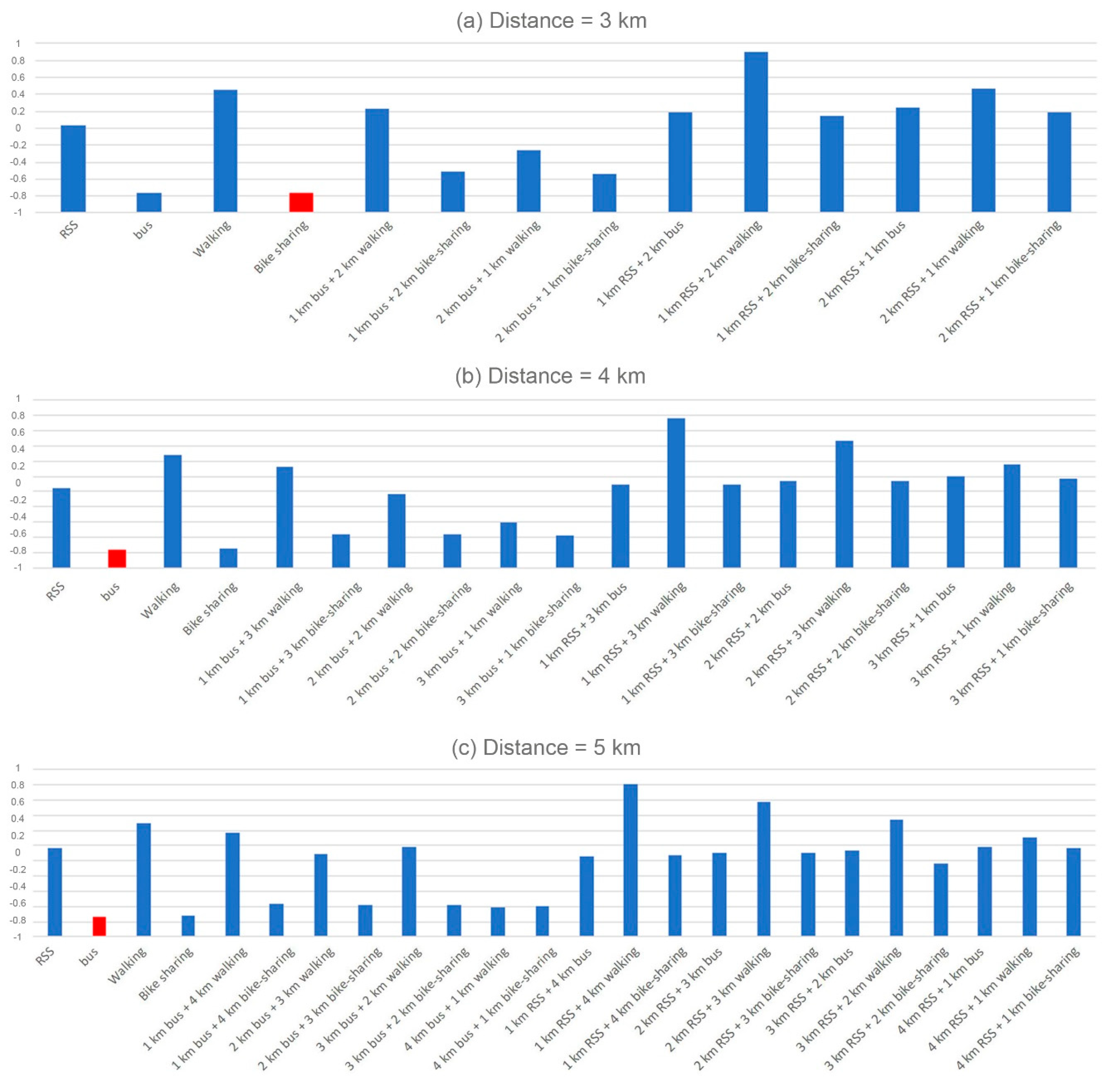Last-Mile Travel Mode Choice: Data-Mining Hybrid with Multiple Attribute Decision Making
Abstract
1. Introduction
2. Literature Review
3. Methodology and Data
3.1. Indicator System for the Last-Mile Travel-Mode Selection
3.1.1. Travel Time
3.1.2. Monetary Cost
3.1.3. Environmental Performance
3.2. Data-Mining-Based Weighting Method
3.3. Data and Preliminary Results
4. Results and Discussion
4.1. Results of Mode Selection for Last-Mile Trips in Five Scenarios
4.2. Discussion
5. Conclusions
Author Contributions
Funding
Acknowledgments
Conflicts of Interest
References
- Cervero, R.; Kockelman, K. Travel demand and the 3Ds: Density, diversity, and design. Transp. Res. D Transp. Environ. 1997, 2, 199–219. [Google Scholar] [CrossRef]
- Yang, L.; Zhou, J.; Shyr, O.F.; Huo, D.D. Does bus accessibility affect property prices? Cities 2019, 84, 56–65. [Google Scholar] [CrossRef]
- Bauman, A.E.; Reis, R.S.; Sallis, J.F.; Wells, J.C.; Loos, R.J.; Martin, B.W. Correlates of physical activity: Why are some people physically active and others not? Lancet 2012, 380, 258–271. [Google Scholar] [CrossRef]
- Yang, L.; Wang, X.; Sun, G.; Li, Y. Modeling the perception of walking environmental quality in a traffic-free tourist destination. J. Travel Tour. Mark. 2019, 1–16. [Google Scholar] [CrossRef]
- Heath, G.W.; Parra, D.C.; Sarmiento, O.L.; Andersen, L.B.; Owen, N.; Goenka, S.; Montes, F.; Brownson, R.C. Evidence-based intervention in physical activity: Lessons from around the world. Lancet 2012, 380, 272–281. [Google Scholar] [CrossRef]
- Cheng, L.; Chen, X.; Yang, S.; Cao, Z.; De Vos, J.; Witlox, F. Active travel for active ageing in China: The role of built environment. J. Transp. Geogr. 2019, 76, 142–152. [Google Scholar] [CrossRef]
- Xu, W.A.; Yang, L. Evaluating the urban land use plan with transit accessibility. Sustain. Cities Soc. 2019, 45, 474–485. [Google Scholar] [CrossRef]
- Xu, W.A.; Zhou, J.; Yang, L.; Li, L. The implications of high-speed rail for Chinese cities: Connectivity and accessibility. Transp. Res. Part A Policy Pract. 2018, 116, 308–326. [Google Scholar]
- Lund, H. Pedestrian environments and sense of community. J. Plan. Educ. Res. 2002, 21, 301–312. [Google Scholar] [CrossRef]
- Leyden, K.M. Social capital and the built environment: The importance of walkable neighborhoods. Am. J. Public Health 2003, 93, 1546–1551. [Google Scholar] [CrossRef]
- Munoz-Raskin, R. Walking accessibility to bus rapid transit: Does it affect property values? The case of Bogotá, Colombia. Transp. Policy 2010, 17, 72–84. [Google Scholar] [CrossRef]
- Zhao, D.; Wang, D. The research of tripartite collaborative governance on disorderly parking of shared bicycles based on the theory of planned behavior and motivation theories—A Case of Beijing, China. Sustainability 2019, 11, 5431. [Google Scholar] [CrossRef]
- DeMaio, P. Bike-sharing: History, impacts, models of provision, and future. J. Public. Trans. 2009, 12, 41–56. [Google Scholar] [CrossRef]
- Velasquez, M.; Hester, P.T. An analysis of multi-criteria decision making methods. Int. J. Oper. Res. 2013, 10, 56–66. [Google Scholar]
- Saaty, T.L. What is the analytic hierarchy process? In Mathematical Models for Decision Support; Springer: Berlin/Heidelberg, Germany, 1988; pp. 109–121. [Google Scholar]
- Emrouznejad, A.; Marra, M. The state of the art development of AHP (1979–2017): A literature review with a social network analysis. Int. J. Prod. Res. 2017, 55, 6653–6675. [Google Scholar] [CrossRef]
- Zhao, R.; Su, H.; Chen, X.; Yu, Y. Commercially available materials selection in sustainable design: An integrated multi-attribute decision making approach. Sustainability 2016, 8, 79. [Google Scholar] [CrossRef]
- Mulliner, E.; Malys, N.; Maliene, V. Comparative analysis of MCDM methods for the assessment of sustainable housing affordability. Omega 2016, 59, 146–156. [Google Scholar] [CrossRef]
- Salonen, M.; Broberg, A.; Kyttä, M.; Toivonen, T. Do suburban residents prefer the fastest or low-carbon travel modes? Combining public participation GIS and multimodal travel time analysis for daily mobility research. Appl. Geogr. 2014, 53, 438–448. [Google Scholar] [CrossRef]
- Ortuzar, J.D.D. Nested logit models for mixed-mode travel in urban corridors. Transp. Res. Part A Policy Pract. 1983, 17, 283–299. [Google Scholar] [CrossRef]
- Stern, S. A disaggregate discrete choice model of transportation demand by elderly and disabled people in rural Virginia. Transp. Res. Part A Policy Pract. 1993, 27, 315–327. [Google Scholar] [CrossRef]
- Schmöcker, J.D.; Quddus, M.A.; Noland, R.B.; Bell, M.G. Mode choice of older and disabled people: A case study of shopping trips in London. J. Transp. Geogr. 2008, 16, 257–267. [Google Scholar] [CrossRef]
- Wang, Q.; Feng, X.S.; Liu, Y.; Wang, X.Y.; Zhang, H.M.Z. Urban Travel Mode Split Optimization Based on Travel Costs. In 9th International Conference on Traffic and Transportation Studies; Mao, B., Tian, Z., Gao, Z., Huang, H., Feng, X., Eds.; Elsevier Science Bv: Amsterdam, The Netherlands, 2014; Volume 138, pp. 706–714. [Google Scholar]
- Schwanen, T.; Dijst, M.; Dieleman, F.M. Leisure trips of senior citizens: Determinants of modal choice. Tijdschr. Econ. Soc. Geogr. 2001, 92, 347–360. [Google Scholar] [CrossRef]
- Su, F.; Schmöcker, J.D.; Bell, M.G. Mode choice of older people before and after shopping. J. Transp. Land Use 2009, 2, 29–46. [Google Scholar] [CrossRef]
- Tilahun, N.; Thakuriah, P.V.; Li, M.; Keita, Y. Transit use and the work commute: Analyzing the role of last mile issues. J. Transp. Geogr. 2016, 54, 359–368. [Google Scholar] [CrossRef]
- Moniruzzaman, M.; Páez, A. Accessibility to transit, by transit, and mode share: Application of a logistic model with spatial filters. J. Transp. Geogr. 2012, 24, 198–205. [Google Scholar] [CrossRef]
- Jenelius, E. Public transport experienced service reliability: Integrating travel time and travel conditions. Transp. Res. Part A Policy Pract. 2018, 117, 275–291. [Google Scholar] [CrossRef]
- Yang, Y.; Wang, C.; Liu, W.; Zhou, P. Understanding the determinants of travel mode choice of residents and its carbon mitigation potential. Energ. Policy 2018, 115, 486–493. [Google Scholar] [CrossRef]
- Koopmans, C.; Groot, W.; Warffemius, P.; Annema, J.A.; Hoogendoorn-Lanser, S. Measuring generalised transport costs as an indicator of accessibility changes over time. Transp. Policy 2013, 29, 154–159. [Google Scholar] [CrossRef]
- Balsa-Barreiro, J.; Li, Y.; Morales, A. Globalization and the shifting centers of gravity of world’s human dynamics: Implications for sustainability. J. Clean. Prod. 2019, 239, 117923. [Google Scholar] [CrossRef]
- He, D.; Liu, H.; He, K.; Meng, F.; Jiang, Y.; Wang, M.; Zhou, J.; Calthorpe, P.; Guo, J.; Yao, Z. Energy use of, and CO2 emissions from China’s urban passenger transportation sector–Carbon mitigation scenarios upon the transportation mode choices. Transp. Res. Part A Policy Pract. 2013, 53, 53–67. [Google Scholar] [CrossRef]
- Cao, X.; Yang, W. Examining the effects of the built environment and residential self-selection on commuting trips and the related CO2 emissions: An empirical study in Guangzhou, China. Transp. Res. D Transp. Environ. 2017, 52, 480–494. [Google Scholar] [CrossRef]
- Neves, A.; Brand, C. Assessing the potential for carbon emissions savings from replacing short car trips with walking and cycling using a mixed GPS-travel diary approach. Transp. Res. Part A Policy Pract. 2019, 123, 130–146. [Google Scholar] [CrossRef]
- Wu, X.; Lu, Y.; Lin, Y.; Yang, Y. Measuring the destination accessibility of cycling transfer trips in metro station areas: A big data approach. Int. J. Environ. Res. Public Health 2019, 16, 2641. [Google Scholar] [CrossRef] [PubMed]
- Ho, W.; Xu, X.; Dey, P.K. Multi-criteria decision making approaches for supplier evaluation and selection: A literature review. Eur. J. Oper. Res. 2010, 202, 16–24. [Google Scholar] [CrossRef]
- Meng, M.; Koh, P.P.; Wong, Y.D. Influence of socio-demography and operating streetscape on last-mile mode choice. J. Public Trans. 2016, 19, 38–54. [Google Scholar] [CrossRef]
- Ji, Y.; Ma, X.; Yang, M.; Jin, Y.; Gao, L. Exploring spatially varying influences on metro-bikeshare transfer: A geographically weighted Poisson regression approach. Sustainability 2018, 10, 1526. [Google Scholar] [CrossRef]
- Jia, L.; Liu, X.; Liu, Y. Impact of different stakeholders of bike-sharing industry on users’ intention of civilized use of bike-sharing. Sustainability 2018, 10, 1437. [Google Scholar] [CrossRef]
- Lin, J.J.; Zhao, P.; Takada, K.; Li, S.; Yai, T.; Chen, C.H. Built environment and public bike usage for metro access: A comparison of neighborhoods in Beijing, Taipei, and Tokyo. Transp. Res. D Transp. Environ. 2018, 63, 209–221. [Google Scholar] [CrossRef]
- Ma, X.; Ji, Y.; Jin, Y.; Wang, J.; He, M. Modeling the factors influencing the activity spaces of bikeshare around metro stations: A spatial regression model. Sustainability 2018, 10, 3949. [Google Scholar] [CrossRef]
- Paul, F.; Bogenberger, K. Evaluation-method for a station based urban-pedelec sharing system. Transp. Res. Proc. 2014, 4, 482–493. [Google Scholar] [CrossRef]
- Bachand-Marleau, J.; Lee, B.H.; El-Geneidy, A.M. Better understanding of factors influencing likelihood of using shared bicycle systems and frequency of use. Transp. Res. Rec. 2012, 2314, 66–71. [Google Scholar] [CrossRef]
- Faghih-Imani, A.; Eluru, N. Determining the role of bicycle sharing system infrastructure installation decision on usage: Case study of montreal BIXI system. Transp. Res. Part A Policy Pract. 2016, 94, 685–698. [Google Scholar] [CrossRef]
- Griffin, G.P.; Sener, I.N. Planning for bike share connectivity to rail transit. J. Public Trans. 2016, 19, 1–22. [Google Scholar] [CrossRef] [PubMed]
- Cervero, R.; Golub, A. Informal transport: A global perspective. Transp. Policy 2007, 14, 445–457. [Google Scholar] [CrossRef]
- Rimmer, P. Paratransit: A commentary. Environ. Plan. A 1980, 12, 937–944. [Google Scholar] [CrossRef]
- Zhao, R.; Min, N.; Geng, Y.; He, Y. Allocation of carbon emissions among industries/sectors: An emissions intensity reduction constrained approach. J. Clean. Prod. 2017, 142, 3083–3094. [Google Scholar] [CrossRef]
- Zhao, R.; Geng, Y.; Liu, Y.; Tao, X.; Xue, B. Consumers’ perception, purchase intention, and willingness to pay for carbon-labeled products: A case study of Chengdu in China. J. Clean. Prod. 2018, 171, 1664–1671. [Google Scholar] [CrossRef]
- Huang, W.; Shuai, B.; Sun, Y.; Wang, Y.; Antwi, E. Using entropy-TOPSIS method to evaluate urban rail transit system operation performance: The China case. Transp. Res. Part A Policy Pract. 2018, 111, 292–303. [Google Scholar] [CrossRef]
- Yap, M.D.; Correia, G.; Van Arem, B. Preferences of travellers for using automated vehicles as last mile public transport of multimodal train trips. Transp. Res. Part A Policy Pract. 2016, 94, 1–16. [Google Scholar] [CrossRef]
- Fransen, K.; Neutens, T.; Farber, S.; De Maeyer, P.; Deruyter, G.; Witlox, F. Identifying public transport gaps using time-dependent accessibility levels. J. Transp. Geogr. 2015, 48, 176–187. [Google Scholar] [CrossRef]



| Travel time | Monetary cost | Environmental Performance | |||
|---|---|---|---|---|---|
| Keyword | Frequency | Keyword | Frequency | Keyword | Frequency |
| Convenience (fangbian, bianli, bianmin, or bianjie) | 8175 | Deposit (yajin) | 3228 | Green (lvse) | 374 |
| Rapid (kuaisu, gaosu, or kuai) | 2294 | Economy (jingji) | 1688 | Alternative energy (xin nengyuan) | 584 |
| Speed (sudu) | 315 | Free (mianfei) | 907 | Energy-saving (jieneng) | 347 |
| Slow (man) | 228 | Hire (zulin) | 593 | Pollution (wuran) | 289 |
| Inconvenience (bubian) | 477 | Charge (shoufei) | 352 | ||
| Efficiency (xiaolv) | 268 | 1 Yuan (yiyuan) | 278 | ||
| Sum | 11,757 | 7046 | 5194 | ||
| Proportion | 0.49 | 0.29 | 0.22 | ||
| Travel Mode | Parameter | Value | Source |
|---|---|---|---|
| Walking | 0.073 km/min | Road Capacity Manual (daolu tongxing nengli shouce) | |
| Bike-sharing | 2.38 min | Field experiment | |
| 0.1895 km/min | Field experiment | ||
| ≥30 min | Field investigation | ||
| 1 Yuan | Field investigation | ||
| Bus | 4.97 min | Field investigation | |
| 0.333 km/min | Implementation Opinions of the Priority Development of Urban Transit in the Chengdu Government (chengdushi renmin zhengfu guanyu youxian fazhan chengshi gonggong jiaotong de shishi yijian) | ||
| 20 Yuan | Field investigation | ||
| ≫20 | Field investigation | ||
| 0 Yuan | Field investigation | ||
| 15.3 kg/GJ | Provincial Guidelines for Greenhouse Gas Inventories (shengji wenshi qiti qingdan bianzhi zhinan) | ||
| 10.91 MJ/km | Patterns and Load of Gas Emissions by the CNG Automobile in Chengdu (chengdushi CNG qiche yongqi guilv ji yongqi fuhe) | ||
| 22.95 | Calculated based on Chengdu Transportation Development Annual Report 2016 | ||
| RSS | 5.6 min | Didi Smart Travel Big Data Report | |
| 1.6 Yuan/km | Field investigation | ||
| 0.593 km/min | Didi 2017 Urban Traffic Travel Report | ||
| 0.3 Yuan/min | Field investigation | ||
| 9 Yuan | Field investigation | ||
| 18.9 kg/GJ | Guidelines for Provincial Greenhouse Gas Inventories | ||
| 0.180 GJ/km | Field investigation | ||
| 2 passengers | Field investigation |
© 2019 by the authors. Licensee MDPI, Basel, Switzerland. This article is an open access article distributed under the terms and conditions of the Creative Commons Attribution (CC BY) license (http://creativecommons.org/licenses/by/4.0/).
Share and Cite
Zhao, R.; Yang, L.; Liang, X.; Guo, Y.; Lu, Y.; Zhang, Y.; Ren, X. Last-Mile Travel Mode Choice: Data-Mining Hybrid with Multiple Attribute Decision Making. Sustainability 2019, 11, 6733. https://doi.org/10.3390/su11236733
Zhao R, Yang L, Liang X, Guo Y, Lu Y, Zhang Y, Ren X. Last-Mile Travel Mode Choice: Data-Mining Hybrid with Multiple Attribute Decision Making. Sustainability. 2019; 11(23):6733. https://doi.org/10.3390/su11236733
Chicago/Turabian StyleZhao, Rui, Linchuan Yang, Xinrong Liang, Yuanyuan Guo, Yi Lu, Yixuan Zhang, and Xinyun Ren. 2019. "Last-Mile Travel Mode Choice: Data-Mining Hybrid with Multiple Attribute Decision Making" Sustainability 11, no. 23: 6733. https://doi.org/10.3390/su11236733
APA StyleZhao, R., Yang, L., Liang, X., Guo, Y., Lu, Y., Zhang, Y., & Ren, X. (2019). Last-Mile Travel Mode Choice: Data-Mining Hybrid with Multiple Attribute Decision Making. Sustainability, 11(23), 6733. https://doi.org/10.3390/su11236733






